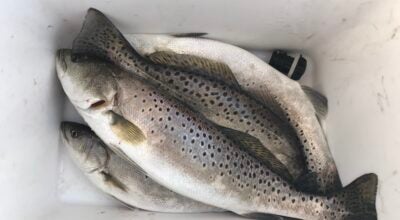Zombie Crabs: The invasion of the body snatchers
Published 8:00 am Saturday, October 19, 2024
|
Getting your Trinity Audio player ready...
|
April Blakeslee, Ph.D., is an assistant professor of Biology at East Carolina University. Since 2016, she and students in her lab have been studying a parasite or specially modified barnacle, that is non-native to North Carolina estuaries and is invading the bodies of native mud crabs and creating what she has called Zombie Crabs. “These parasites invade the host bodies of these little mud crabs,” said Blakeslee. “At that point, the mud crabs are no longer in control of their bodies. The parasites replace the hosts’ reproductive system with their own, rendering the mud crab reproductively dead, and begin producing their own spawn. We call this parasitic castration. At that point, the mud crabs are like the Walking Dead or a Zombie.”
Blakeslee said the parasites and Zombie crabs are native to the Gulf of Mexico, and it wasn’t until the 1950s or 1960s that they were introduced along the Atlantic coast. “As the oyster populations started to decline along the Chesapeake Bay, oysters were moved from the gulf to supplement those populations. We believe that some of those infected crabs and parasites got moved with those oysters. Crabs in our Atlantic waters are naive to this infection, so they are highly susceptible. So, we see really, really, high infection rates in our estuaries, much higher than in the Gulf of Mexico. This is why we continue to monitor for Zombie Crabs here in our local waters.”
This is done by using what is called ‘Crab Condos,’ a concept that was developed by the Smithsonian. Two of which are located along the dock by the NC Estuarium in Washington. “We fill them with ostler shells and other native habitat,” said Kate McCullough, curator at the NC Estuarium. “They allow the mud crabs and other inhabitants such as mussels, eels, and other crabs to come and go freely. It allows us and Dr. Blakeslee to check the mud crabs for parasites and to test the salinity of the water.”
Blakeslee said they have a total of ten ‘Crab Condos” in place along the Pamlico River that they check throughout the year. What they do know is that the parasites thrive in water with is higher in salinity. “We have yet to see evidence of the parasite in the Estuarium area because the salinity is too low,” said Blakeslee. “But closer to Swan Quarter, where we have the condos, we are starting to see the parasite show up. This is why it is important to continue to check the salinity levels in our estuaries. As ocean levels continue to rise, it creates a scenario for the intrusion of saltier water further inland.”
Blakeslee said, although tiny and no more than three inches in width, mud crabs play an important role in our bio-ecosystem. “They are prey species for a lot of different organisms and prey on a lot of different organisms themselves,” said Blakeslee. “They are also scavengers, so they do a lot of cleanup work as well as they eat up a lot of dead stuff.”
What, if anything, can be done concerning the invasion of the parasites is a dilemma that Blakeslee and her students continue to research. “What we have to do is try and figure out ways of preventing future spreads of the parasites, and not harm the mud crab population, which is no easy task,” said Blakeslee. “They can easily be introduced to non-native waters, as we have learned, by the moving of oyster populations. And we know they can also be moved around by attaching themselves to ships. And of course, as the inland waters in our estuaries become saltier, they become favorable habitats for the parasites.”
Blakeslee said if the mud crab population continues to decline as a result of being invaded by the parasites, there will be a change in the dynamics of the current bio-eco systems. “This is why we continue our research and monitor the situation,” said Blakeslee. “This invasion of the parasite may be having a bigger impact than we really know at this time.”
A Zombie Crab exhibit is currently on display at the NC Estuarium.








